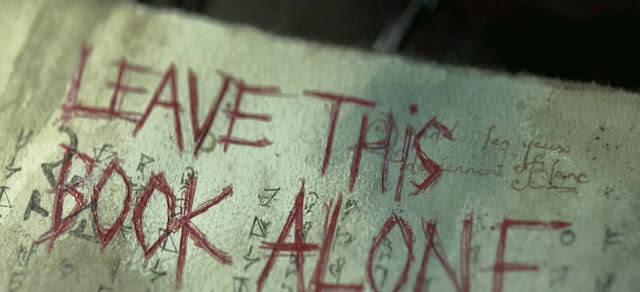A Brief History of the Necronomicon
After my recent viewing of Evil Dead (2013), I found myself thinking about the subtle (and not so subtle) Lovecraftian elements, particularly the creepy arcane tome found in the cellar of the cabin. A prominent feature of the earlier Evil Dead films too, the Necronomicon is an ancient (fictional) grimoire containing summoning spells, incantations, the laws of the dead and various accounts of an unknowable pantheon of cosmic deities known as the Great Old Ones. The Necronomicon was created by HP Lovecraft and appeared in many of his stories. According to Lovecraft scholar ST Joshi, the author was likely inspired to create a fictional grimoire that could drive its reader insane and unleash incomprehensible cosmic horrors from the beyond, by a collection of short stories by Robert Chambers, The King in Yellow (1895). In his essay Supernatural Horror in Literature (1927), Lovecraft describes this collection as: “a series of vaguely connected short stories having as a background a monstrous and suppressed book whose perusal brings fright, madness, and spectral tragedy.”
 |
| Evil Dead (2013) |
Who doesn't love spectral tragedy? Lovecraft would go on to flesh out the background of the Necronomicon in The History of the Necronomicon (1938), a short story in the guise of a pseudo-historical account of the authoring and subsequent translations and publication of the mysterious tome. Lovecraft suggests the book was authored by the ‘Mad Arab’ Abdul Alhazred, a worshipper of Cthulhu in the 700s. After Alhazred’s ‘sudden and mysterious’ death, the book was translated into Greek from the obscure form of Arabic it was originally written in, and according to Lovecraft’s history of the work, this version “impelled certain experimenters to terrible attempts” before it was suppressed from circulation and burnt. Certain copies still existed however, and in the 13th century it was translated into Latin before being banned outright by Pope Gregory IX. Latin editions appeared in Europe between the 15th and 17th centuries and eventually fragments of an English translation appeared, though this was never published. According to Lovecraft, it was the astrologer/occultist/magician John Dee who translated the text into English.
| Evil Dead (1981) |
Lovecraft purported that original copies of the Necronomicon were held under lock and key by only a select few institutions throughout the world, including the British Museum and the library at the Miskatonic University in Arkham. The character of Wilbur Whateley (the monstrous offspring of a human woman and the cosmic deity Yog-Sothoth) in The Dunwich Horror (1929) visits the university library “in quest of the dreaded volume […] the hideous Necronomicon of the mad Arab Abdul Alhazred in Olaus Wormius’ Latin version, as printed in Spain in the seventeenth century […] Wilbur had with him the priceless but imperfect copy of Dr Dee’s English version which his grandfather had bequeathed him, and upon receiving access to the Latin copy he at once began to collate the two texts with the aim of discovering a certain passage which would have come on the 751st page of his own defective volume” (Lovecraft, The Thing on the Doorstep and Other Weird Stories, Penguin, 2002, p219). Indeed, it is the character of the chief librarian at Miskatonic, Dr Henry Armitage, who realises what Whateley is up to (attempting to summon Yog-Sothoth) and sets out, along with other faculty members, to stop him.
 |
| Evil Dead (2013) |
Throughout the years the Necronomicon was referenced in stories and novels by the likes of August Derleth, Robert Bloch and Robert E Howard – friends and contemporaries of Lovecraft - who all contributed to the Cthulhu Mythos created by him. In the Evil Dead films, the book is referred to as the Necronomicon Ex-Mortis, and is bound in human skin. It is discovered by a group of friends in the cellar of a remote cabin in the woods who eventually, unwittingly, use it to summon dormant demonic forces slumbering in the surrounding forest. It even makes a brief appearence in Jason Goes to Hell: The Final Friday (1993).
There have also been instances over the years where pranksters have slipped cards for the book into various university library card catalogues. I find myself wondering what system would be used to classify it and what its shelf number would be... Perhaps, if using Dewey, located in Class 100 – Philosophy & psychology, specifically 130 - Parapsychology & occultism? I'll just pop down to the closed access stacks to check. Be right back...



